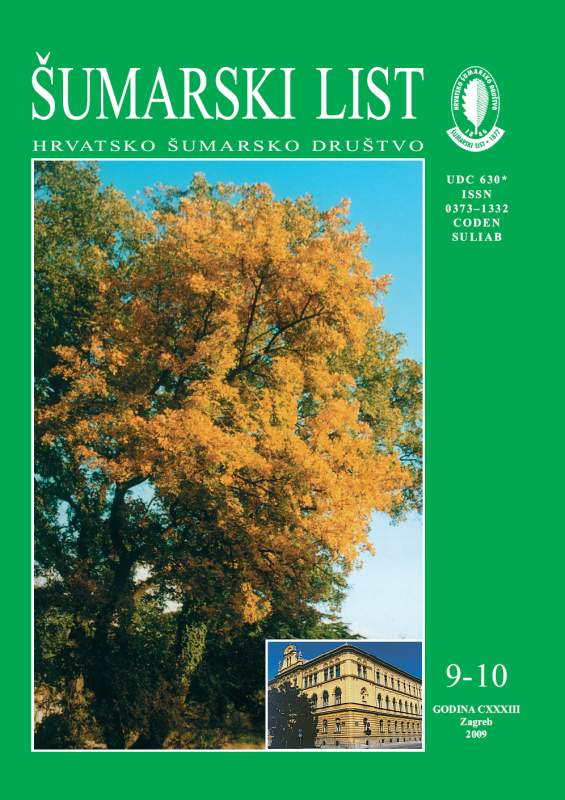
broj: 9-10/2009
pdf (8,1 MB) |
|
||||||||||||||
| RIJEČ GLAVNOGA UREDNIKA | ||
| Branimir Prpić | ||
| ON THE ORGANISATIONAL STRUCTURE OF THE COMPANY “HRVATSKE ŠUME” Ltd pdf HR EN | 468 | |
| Changing trends of life are forcing us to increasingly view forestry, and indirectly timber processing, from the aspectof economics. The Faculty of Economics in Zagreb, which has been entrusted with the task, has accomplished the jobwith utmost professionalism and meticulousness. The role of forestry is twofold: on the one hand forests must be preserved in their proper condition so that they couldprovide beneficial functions in the biosphere, and on the other, they must fulfill human demand for timber, the noblestof the raw materials that exist in the living nature. For over 160 years, the forestry profession has strived, with ups and downs, to retain this sensitive balance throughits NGO, Croatian Forestry Association. We like to believe that we have successfully accomplished this mission for generations to come. Today, Croatia has over 90 % of natural forests that fulfill both roles mentioned above, which differentiates us from the majority of European countries. The Croatian Forestry Association has participated in the debateon the restructuring organized by the Faculty of Economics, and has also held a separate discussion at their ManagingBoard. At the former gathering, which was attended by representatives of the Croatian forestry practice and science,some basic postulates were enhanced as the key elements of the future structure of the profession. The greatest gift of Croatian forestry to the world – sustainable management – should be further improved and developed. According to the conclusions of the 1992 Rio de Janeiro Conference, sustainable development should be transposed to all fields of life. This refers particularly to sustainable conservation of all non-timber functions that are rapidly becoming our greatest wealth. We should continue to pay non-timber forest function fees for the purpose of restoring our continental and Mediterranean forests damaged by anthropogenic impacts. We should continue with the maintenance of forest infrastructure – forest roads, forest keepers’ cabins, hunting lodges, trade union resorts and others. Working conditions in forestry are extremely hard, so shelters, resting places andother amenities must be provided for forestry workers. Great quantities of ecologically suitable building material areideal for meeting these requirements. The choice of forestry cadres should be left to the forestry profession itself. Political decisions in this field can befatal, since these decisions are largely influenced by interests and profits of other professions (e.g. the Danube – Savacanal and other operations that alter water conditions at the detriment of forests, permanent cultures in theMediterranean, etc.). Experienced and reputed cadres should be promoted to the top of the profession (Ministry,Direction), while younger professionals should prove themselves in forest administrations and offices. Although we haveresisted decentralization of the forestry organization for almost 20 years, it is a sine qua non for progress. Forestry should be within the Ministry together with forest protection and state administration for water management. The minister should definitely be a forestry professional, while national parks and nature parks that feature forestsas the basic phenomena should be managed by the company “Hrvatske Šume” Ltd, whose professionals have proventime and again that they know how to conserve nature. In addition, this would save considerable means for the State. Professor Emeritus Branimir Prpić, Ph.D. | ||
| IZVORNI ZNANSTVENI ČLANCI | ||
| Seletković,I., N. Potočić,A. Jazbec,T. Ćosić,T. Jakovljević | UDK 630* 232.2 + 232.3 (001) | |
| The Influence of Various Growing Substrates and Slow-release Fertilizers on the Growth and Physiological Parameters of Common Beech (Fagus sylvatica L.) Seedlings in a Nursery and Following Planting in the Field pdf HR EN | 469 | |
| Tanušev,V., J. Ištvanić, M. Moro, J. Butković | UDK 630* 333 + 83 (001) | |
| Yield of Low Quality and Small-Sized Diameter Common Beech (Fagus sylvatica L.) Logs in Rough Dimension Stock Production pdf HR EN | 483 | |
| Šušnjar, M., D. Pičman,T. Pentek, D. Horvat, H. Nevečerel, K. Greger | UDK 630* 383 + 432 (001) | |
| Working Characteristics of Terrain Leveler Machine in Forest Fire Road Construction and Carst Melioration pdf HR EN | 493 | |
| Ballian, Dalibor | UDK 630* 165 (001) | |
| Genetic Structure of Silver Fir (Abies Alba Mill.) from Western and Eastern Bosnia pdf HR EN | 501 | |
| Bobinac, M., S.Andrašev | UDK 630* 25 (001) | |
| Effects of Silvicultural Measures in Devitalized Middle Aged Oak Stand (Quercus Robur L.) on Chernozem in Vojvodina pdf HR EN | 513 | |
| Farkaš,V., T. Gomerčić, M. Sindičić,V. Slijepčević, Đ. Huber,A. Frković, S. Modrić | UDK 630* 156 (001) | |
| CraniometricalAnalysis and Determination of Sexual Dimorphism in Brown Bear (Ursus arctos L.) from Croatia pdf HR EN | 527 | |


